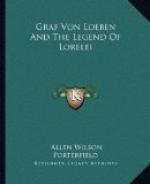[86] Niklas Vogt included, to be sure, in his Jugendphantasien
Ueher
die Sagen des Rheins (ca.
1811) an amplified
recapitulation in prose of
Brentano’s ballad. Schreiber knew this
work, for in his Handbuch
there is a bibliography of no
fewer than ten pages of “Schriften,
welche auf die Rheingegend
Bezug haben.” So
far as one can determine such a matter from mere
titles, the only one of these
that could have helped him in the
composition of his Lorelei-saga
is: Rheinische Geschichten und
Sagen, von Niklas Vogt.
Frankfurt am Main, 1817, 6 BAende.
[87] Eduard Thorn says (p. 89): “Man darf
annehmen, dass Heine die
Ballade Brentano’s kennen
gelernt hat, dass er aus ihr den Namen
entlehnte, wobei ihm Eichendorff
die Fassung ‘Lorelei’ lieferte,
und das ihm erst Loebens Auffassung
der Sage zur Gestaltung
verhelfen hat.”
It sounds like a case of ceterum censeo,
but Thorn’s argument
as to Brentano and Heine is so thin that this
statement too can be looked
upon only as a weakly supported
hypothesis.
[88] Cf. Raimund Pissin’s monograph, pp. 73-74.
[89] There are about two thousand words in Schreiber’s
saga, and about
five thousand in Loeben’s.
[90] It must be remembered that Schreiber’s
manuals are written in an
attractive style: his
purpose was not simply to instruct, but to
entertain. And it was
not simply the legends of the Rhine and its
tributaries, but those of
the whole of Western Germany that he
wrote up with this end in
view.
[91] Some minor details that Loeben, or Heine, had
he known the
MAerchen in 1823, could
have used are pointed out in Wilhelm
Hertz’s article, pp.
220-21.
[92] Cf. GOerres’ edition, pp. 94-108.
[93] Cf. ibid., pp. 128-40, and 228-44.
It is in this
MAerchen (p. 231) that
Herzeleid sings Goethe’s “Wer nie
sein Brod in ThrAenon asz.”
[94] Cf. GOerres’ edition, pp. 247-57.
There are a number of details in
this MAerchen that
remind strongly of Fouque’s Undine,
which Brentano knew.
[95] In his Die MAerchen Clemens Brentanos,
KOeln, 1895,
H. Cardauns gives an admirable
study of Brentano’s MAerchen,
covering the entire ground
concerning the question whether
Brentano’s ballad was
original and pointing out the sources and
the value of his, RheinmAerchen.
Cardauns comes to the only
conclusion that can be reached:
Brentano located his ballad in a
region replete with legends,
but there is no positive evidence
that he did not wholly invent
his own ballad. The story that
Hermann Bender tells about
having found an old MS dating back to
the year 1650 and containing




